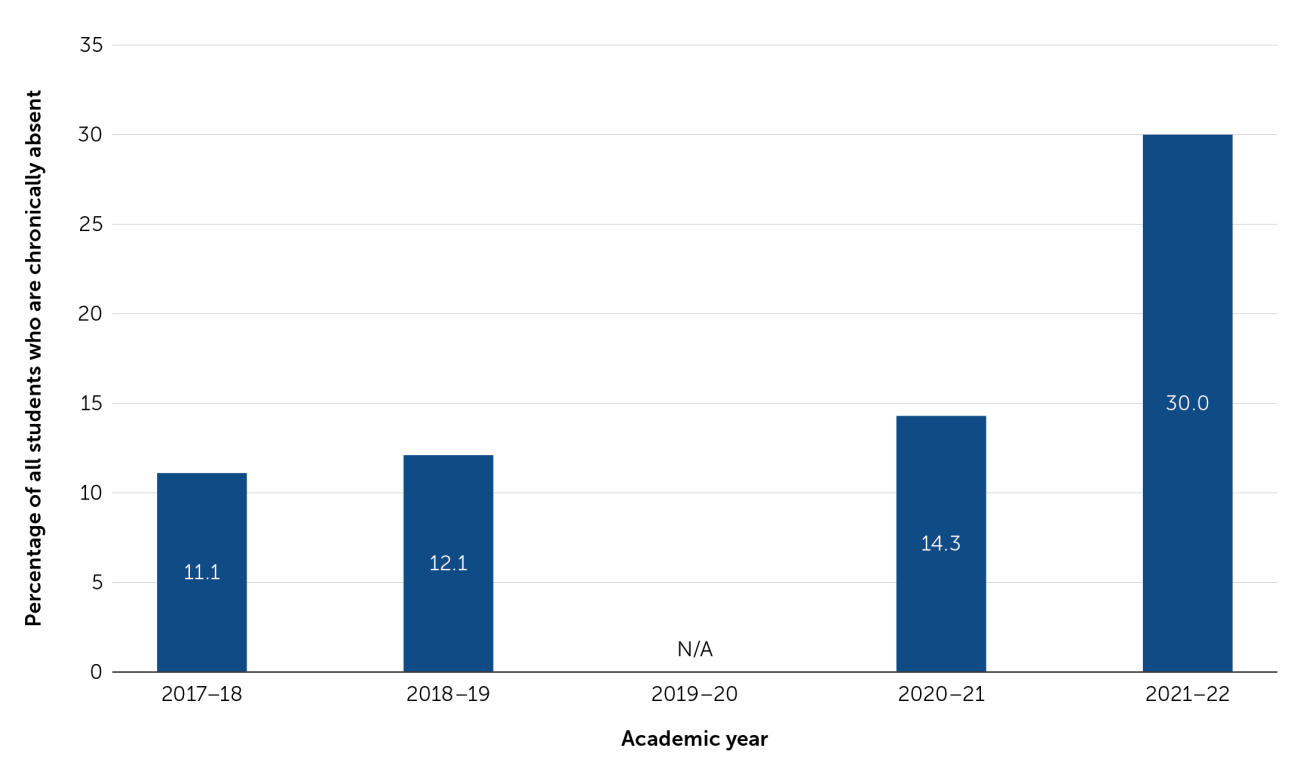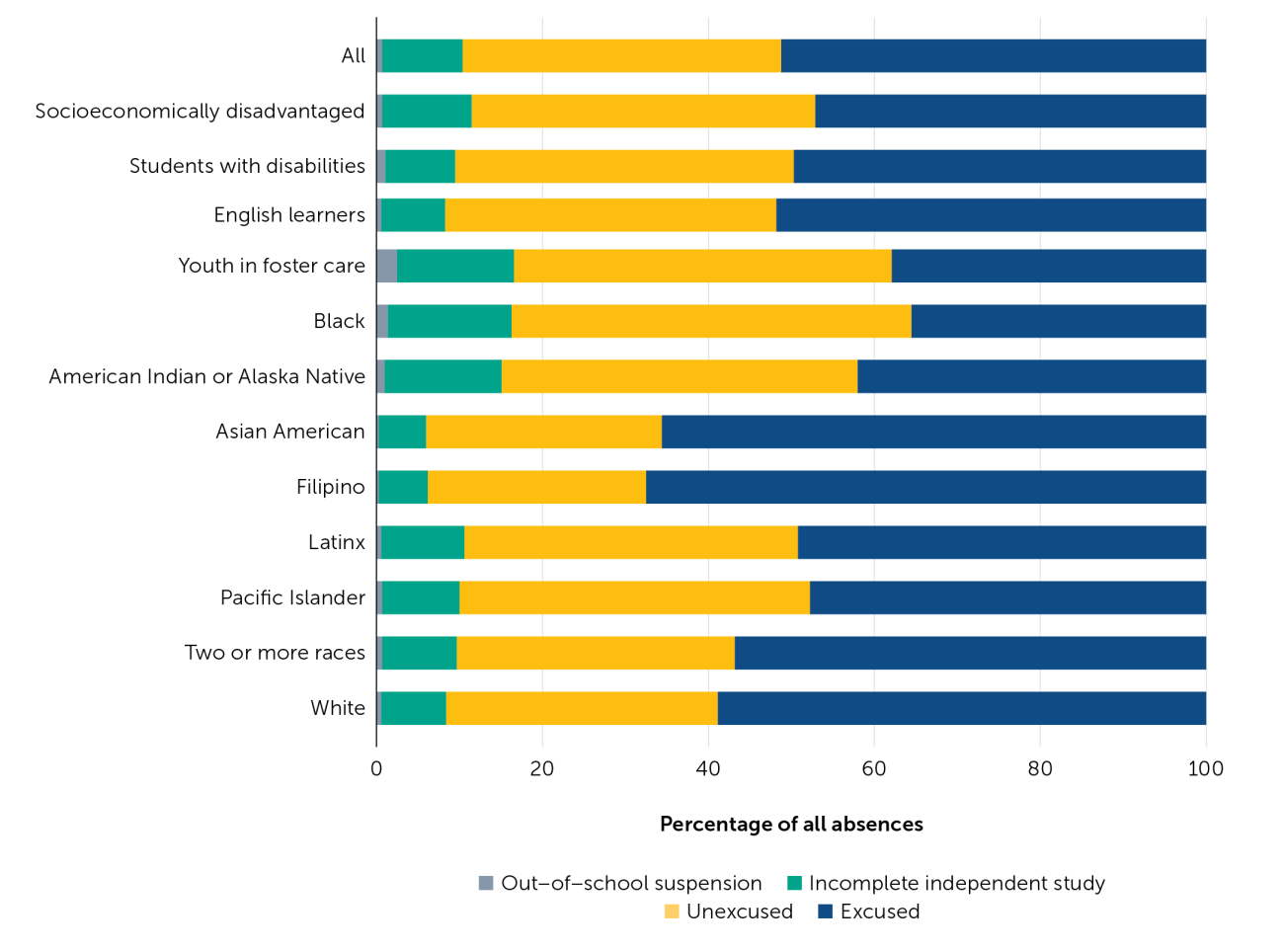Chronic Absenteeism Post-Pandemic

Figure 1. Chronic Absenteeism for All Students by Year

Source. Based on chronic absenteeism data from the California Department of Education.
Addressing absenteeism requires an urgent response given the lasting consequences it can have on students’ outcomes, including their academic achievement and graduation. Missed classes mean missed opportunities to learn. If too many students are absent, then teachers also face challenges in teaching. This sets up a troubling cycle, especially given the need to ramp up learning to overcome academic setbacks students experienced during the pandemic.
Figure 2. Change in Chronic Absenteeism From 2018–19 to 2021–22 by Student Subgroup

Source. Based on chronic absenteeism data from the California Department of Education.
To be considered chronically absent, students must miss 10% or more days of school (which translates to 18 or more instructional days for students enrolled the whole year), which can include a combination of excused and unexcused absences—reflecting the fact that being absent from school, regardless of the reason, can be detrimental to learning. Excused absences are ones that the school or district deems to be “legitimate” based on reasons defined in the California Education Code (Section 48205), such as a medical reason with a doctor’s note. Unexcused absences are ones that schools recognize as not having a valid reason, such as missing school without permission. Accumulating too many unexcused absences places the child at risk of becoming classified as “truant.” As a new PACE report shows, there are escalating punitive consequences for truancy, including court involvement.
Students who identify as Black, Native American, Latinx, and Pacific Islander have more of their absences labeled unexcused than their White, Asian American or Filipino peers (see Figure 3). The high rates of chronic absenteeism for students in these groups, plus the fact that more of their absences are unexcused, mean that they and/or their parents could face more punitive actions. Such actions include involvement with the court system for too many unexcused absences as well as greater risks of not being able to engage academically—missing opportunities to complete make-up work is a penalty for unexcused absences—as well as nonacademically, such as exclusion from extracurricular activities.
Figure 3. Reasons for Absences in 2021–22 Statewide by Student Subgroup

Source. Based on absenteeism by reason data from the California Department of Education.
Where do we go from here?
Tackling these unprecedentedly high rates of absenteeism across our state will require multifaceted approaches, including proactive engagement with families and students, real-time data to inform decision-making, and a holistic understanding of factors that both push students out and pull them in.
- Engaging with parents and students remains the cornerstone of any strategy to promote attendance. Engagement must be grounded in positive, proactive problem-solving. Recently, Connecticut’s home visitation program has shown promising results. An interdisciplinary team of educators and school personnel made home visits to families whose children struggled with attendance, proactively providing them with necessary learning and/or behavioral supports to boost attendance.
- California’s schools and school districts should continue to leverage their continuous improvement processes that analyze absence data in real time to identify groups who show early warning signs of disengagement. Although past data are important for understanding prior patterns and trends, data in real time can be leveraged in preventive planning.
- Schools should continue to focus on strengthening supports aimed at more broadly tackling the learning and schooling conditions that are intertwined with absenteeism—in particular, mitigating the push-out factors and focusing on the pull-in factors. Critically, we must ask: How do we make schools safe, welcoming, and supportive spaces that draw students in?
- Finally, because the reasons for absences are multifaceted and involve challenges that schools, families, and communities face, the solutions to chronic absenteeism do not lie with schools alone—our school transportation systems, the public health system, and social welfare systems all matter.
Although confronting such large increases in absenteeism may feel like uncharted territory, the good news is that schools throughout our state were actively engaged in these approaches prior to the pandemic. Looking ahead, though, we see that the types of student groups experiencing absenteeism and the underlying reasons for chronic absenteeism may have changed, requiring an even more intensive focus on and broader outreach to groups that typically did not experience attendance challenges in the past.
Gee, K., Hough, H. J., & Chavez, B. (2023, March). Chronic absenteeism post-pandemic: Let’s not make this our “new normal” [Commentary]. Policy Analysis for California Education. https://edpolicyinca.org/newsroom/chronic-absenteeism-post-pandemic



